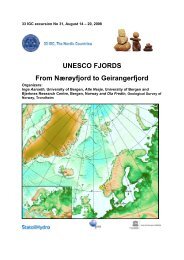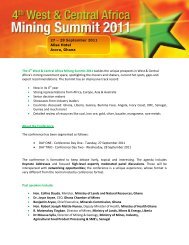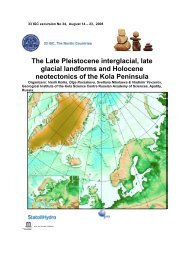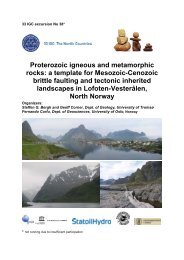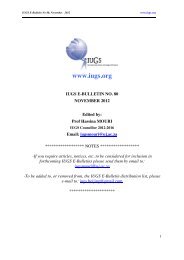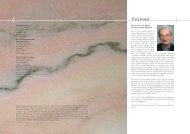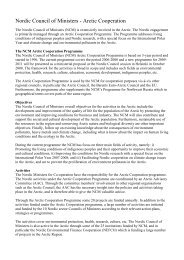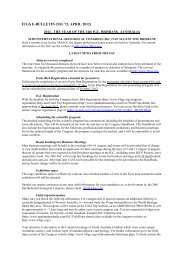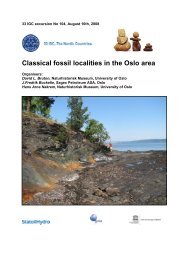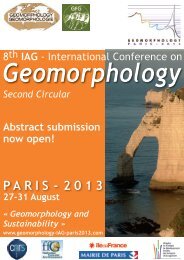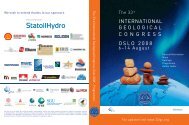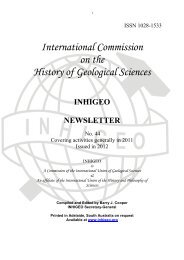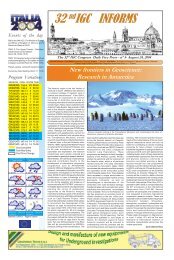The Second International Geological Congress, Bologna, 1881 - IUGS
The Second International Geological Congress, Bologna, 1881 - IUGS
The Second International Geological Congress, Bologna, 1881 - IUGS
Create successful ePaper yourself
Turn your PDF publications into a flip-book with our unique Google optimized e-Paper software.
18<br />
agreed to entrust to Germany the preparation of the <strong>Geological</strong> Map<br />
of Europe at a scale 1:1,500,000 and to set up an <strong>International</strong> Committee<br />
of five plus two members to exercise permanent scientific<br />
control over the undertaking. As soon as the Committee was<br />
appointed, it was charged with the responsibility for addressing<br />
issues of nomenclature and cartographic symbolism not yet decided<br />
upon, or unlikely to be resolved easily, by the <strong>Congress</strong>. This Committee<br />
was the original seed from which sprang the subsequent Commission<br />
for the <strong>Geological</strong> Map of the World.<br />
Later discussion concentrated on the map’s symbols and especially<br />
the standard colours to be used for the principal geological<br />
divisions. Lively exchanges took place<br />
on both the physical attributes and aesthetics<br />
of the colours. Comparable discussions<br />
surrounded also the other recommendations<br />
of Commission 2. It<br />
became increasingly relevant the role of<br />
Renevier (Figure 10) to lead these discussions<br />
in the direction of adopting the suggestions<br />
of the Commission or of reaching<br />
a reasonable compromise, and in this<br />
challenge he was supported by the judicious<br />
chairmanship of Capellini. As a<br />
consequence and in final analysis, only<br />
Figure 10 Renevier’s one recommendation made by Commis-<br />
card to Capellini apolosion 2 was left to the <strong>International</strong> Comgizing<br />
for some eyes mittee, with addition of the colours to be<br />
illness and adding used for the post-Tertiary terrains. On the<br />
contributions to the latter point, however, it was already clear<br />
Bibliographie volume that most speakers favoured separating<br />
(Figure 2) (Capellini the Quaternary from both the Cenozoic<br />
Museum).<br />
and the Tertiary (Anonymous, 1882, p.<br />
156).<br />
<strong>The</strong> last session of the <strong>Congress</strong> was devoted to the report of<br />
Commission 3. <strong>The</strong> basic principles for naming organisms were<br />
agreed upon: (i) binomial nomenclature; (ii) Latin names for genera<br />
and species; and (iii) priority rule. Be that as it may, great differences<br />
in practice, however, were recognized between botanists and zoologists.<br />
<strong>The</strong>re was debate as to whether the Linnaeus’ Systema Naturae<br />
(1776 edition) should be taken as the starting point for priority in<br />
palaeontological nomenclature, or if it would have been appropriate<br />
to go back to Aldrovandi or, even earlier, to Pliny, as the Commission<br />
had suggested. Various national botanical societies warned the<br />
<strong>Bologna</strong> IGC to conform to their 1867 resolutions. <strong>The</strong>re was discussion<br />
about the need to follow binomial nomenclature and yet at<br />
the same time distinguish variability within species attributable to<br />
both geographical spread (“varieties”) and chronological change<br />
(“mutations”). Another matter for debate was the theoretical and<br />
practical importance of maintaining the name of the author of a<br />
species independent from that of the genus to which was assigned.<br />
President Capellini skilfully won adoption of all the clauses presented<br />
for discussion in the report of Commission 3, winning over<br />
conflicting groups by incorporating relevant minority views and, in<br />
opposition to the Commission’s recommendation, by limiting priority<br />
to Linnaeus’ Systema Naturae (1776 edition).<br />
Thus, after five days of session, the <strong>Bologna</strong> IGC succeeded in<br />
reaching consensus on about 95% of the issues examined by the ad<br />
hoc Commissions established following the first IGC in Paris. <strong>The</strong><br />
number of Italian voting members contributed to this result because<br />
they were predisposed so to do, or were quickly persuaded to respect<br />
the careful preparatory work and skillful chairmanship of Capellini.<br />
With the exception of Sella and Meneghini, only a minority of the<br />
Italians took part in the discussions, but often making irrelevant, if<br />
not actually disruptive, remarks. <strong>The</strong> most active discussants were<br />
the French, Germans, and Russians, with the crucial role in reconciling<br />
their commonly discrepant views played continuously by<br />
Renevier (Switzerland) and partly by Fontannes. In contrast, James<br />
Hall was silent after his major speech in favour of a common geological<br />
language at the Paris IGC (Anonymous 1880, p. 60-67), and<br />
Moisisovics maintained his sceptic’s role already declared at the<br />
Paris <strong>Congress</strong>.<br />
An average of 100 voting members attended the plenary sessions<br />
at the <strong>Bologna</strong> IGC. <strong>The</strong>se were not the only sessions, however,<br />
that contributed to the successful outcome of the second <strong>Congress</strong>:<br />
additional work as performed during informal morning meetings<br />
and during afternoon and evening visits to the First <strong>Geological</strong><br />
Exhibition and to museums and other institutions. <strong>The</strong> Austrian<br />
National Committee’s submission of the proposal to the <strong>Bologna</strong><br />
Organizing Committee to construct a <strong>Geological</strong> Map of Europe was<br />
a further important contribution to the success of the <strong>Bologna</strong> IGC.<br />
At the brief but solemn closing ceremony on October 2, <strong>1881</strong>,<br />
additional accomplishments of the Council were to ensure both<br />
implementation of the resolutions adopted and completion of others<br />
not yet fully resolved, as soon as possible, and the setting up of a new<br />
<strong>International</strong> Commission on Nomenclature (forerunner of the future<br />
<strong>International</strong> Commission on Stratigraphy). Whereas the official<br />
reason advanced for the establishment of this new Commission was<br />
the great amount of work still to be done, one may guess that it was<br />
set up also to counterbalance the powers assigned to the Committee<br />
for the <strong>Geological</strong> Map of Europe. In fact, the Commission, comprising<br />
one representative from each of the 16 countries present at<br />
the <strong>Congress</strong>, was foreseen by <strong>Congress</strong> leadership to work at a level<br />
of importance higher than the Committee. As it transpired, however,<br />
both bodies were to meet at least twice before the following <strong>Congress</strong><br />
— in 1882 with the Société Géologique de France and in 1883<br />
with the Société Helvetique de Sciences naturelles.<br />
As for the nomenclature applied to palaeontological species,<br />
beyond the resolutions adopted at the <strong>Congress</strong>, the Council (Figure<br />
11) called for a common agreement on nomenclatorial practices with<br />
the Botanical and Zoological Societies.<br />
Other accomplishment of the 2nd IGC in <strong>Bologna</strong>, <strong>1881</strong>,<br />
should not be overlooked, even though they must be judged of lesser<br />
importance by virtue of not being the subjects of preparatory work<br />
by Commissions prior to the event itself. Thus, for example, igneous<br />
petrology, in the form of general questions bearing on the origins of<br />
serpentinite and trachyte, was addressed in special conferences. An<br />
accomplishment of an utterly contrasted type was the foundation of<br />
the Società Geologica Italiana, for which the <strong>Congress</strong> provided a<br />
favourable environment, including that for the immediate collection<br />
of subscriptions from many future foreign members.<br />
<strong>The</strong> Council expressed its gratitude to the OC for the interest<br />
and usefulness of the <strong>Geological</strong> Exhibition, requesting each ensuing<br />
IGC to follow the example given by <strong>Bologna</strong>. <strong>The</strong> great advancement<br />
made by the <strong>Congress</strong> in reconciling international views on the<br />
standardization of stratigraphical and palaeontological nomenclature<br />
also gave vent to recommendations for future IGCs, with the suggestion<br />
that they could well reach beyond the problems of finding a<br />
common international geological language and seek comparable reconciliation<br />
on key issues in pure science of common interest.<br />
Among the numerous official speeches, greetings, and comments<br />
made during discussion, it is notable that: (1) Hébert, in mentioning<br />
the ongoing <strong>Bologna</strong> <strong>Congress</strong>, referred to “un premier congrès”<br />
(Anonymous, 1882, p. 98) or “ce premier congrès” (p. 116),<br />
indicating that he himself considered the <strong>Bologna</strong> IGC to be the first<br />
<strong>Congress</strong>, following upon the launching of such events in Paris in<br />
Figure 11 Fifty-six Council members gathering around Capellini<br />
(sixth from left in the front row sitting) at the 2nd IGC <strong>Bologna</strong><br />
<strong>1881</strong> (Capellini Museum).<br />
March 2004



